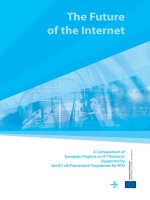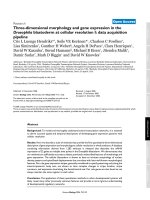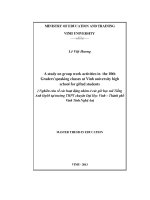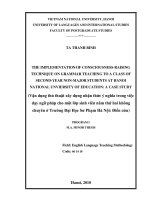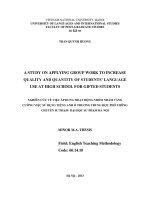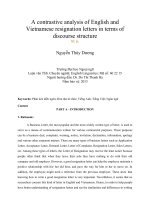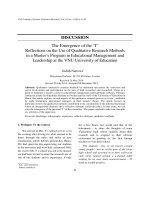Code mixing used on facebook social network by EFL students at high school for gifted students, hanoi national university of education
Bạn đang xem bản rút gọn của tài liệu. Xem và tải ngay bản đầy đủ của tài liệu tại đây (1.08 MB, 77 trang )
VIETNAM NATIONAL UNIVERSITY, HANOI UNIVERSITY OF
LANGUAGES AND INTERNATIONAL STUDIES FACULTY OF
POST-GRADUATE STUDIES *********************
NGUYỄN THỊ VÂN
“CODE MIXING USED ON FACEBOOK SOCIAL
NETWORK BY EFL STUDENTS AT HIGH SCHOOL FOR
GIFTED STUDENTS, HANOI NATIONAL UNIVERSITY
OF EDUCATION”
Hiện tượng trộn mã tiếng Anh trên mạng xã hội Facebook của học sinh
chuyên Anh ở trường chuyên Sư Phạm Hà Nội
M.A THESIS
FIELD
: ENGLISH LINGUISTICS
CODE
: 8220201.01
Hanoi, 2018
VIETNAM NATIONAL UNIVERSITY, HANOI UNIVERSITY OF
LANGUAGES AND INTERNATIONAL STUDIES FACULTY OF
POST-GRADUATE STUDIES ******
******
NGUYỄN THỊ VÂN
“CODE MIXING USED ON FACEBOOK SOCIAL NETWORK BY EFL
STUDENTS AT HIGH SCHOOL FOR GIFTED STUDENTS, HANOI
NATIONAL UNIVERSITY OF EDUCATION”
Hiện tượng trộn mã tiếng Anh trên mạng xã hội Facebook của học sinh
chuyên Anh ở trường chuyên Sư Phạm Hà Nội
M.A THESIS
FIELD
: ENGLISH LINGUISTICS
CODE
: 8220201.01
SUPERVISOR
: Dr. Nguyen Thi Minh Tam
Hanoi, 2018
DECLARATION
I hereby certify that the minor thesis entitled “Code mixing used on
Facebook social network by EFL students at High School for Gifted Students,
Hanoi National University of Education” is the result of my own work in partial
fulfillment of the requirements for the degree of Master of Arts in English
Linguistics at Faculty of Post-graduate Studies, University of Languages and
International Studies, Vietnam National University, Hanoi. The research has not
been submitted to any other university or institution wholly and partially.
Hanoi, 2018
ACKNOWLEDGEMENTS
This thesis could not have been completed without the help and support from
a number of people.
First and foremost, I would like to express my sincere gratitude to Dr.
Nguyen Thi Minh Tam, my supervisor, who has patiently and constantly supported
me through the stages of the study, and whose stimulating ideas, expertise, and
suggestions have inspired me greatly through my growth as an academic researcher.
A special word of thanks goes to my students, without whom it would never
have been possible for me to have this thesis accomplished.
Last by not least, I am greatly indebted to my family for the sacrifice they
have devoted to the fulfillment of this academic work.
ABSTRACT
English have been nationwide taught in all Vietnamese schools for the past ten
years; consequently, Vietnamese youngsters nowadays could be exposed to English
at the early age, and consequently, English turns out to be familiar with them. Under
the boom of entertainment industry and Western influence, English, more or less,
become preferable in social network; so the mixing of English into Vietnamese has
emerged as a quite visible case in social network communication. Code-mixing,
according to Poplack (1980), Holmes (1992) and Liu (2008), refers to both intersentential and intra-sentential code-altemation occurring when a bilingual speaker
uses more than one language in a single utterance above the clause level to
appropriately convey his/her intents. That is, code mixing is the process of mixing
the various language units below clause level within a sentence. Code-mixing has
become such a topic of good interest that quite a number of researchers have studied
it in both spoken and written data, such as H.D.Tuc (2003) and T.T. Cuc (2012). In
this study, attempts were made to investigate the patterns and levels of code-mixing
of English by EFL students in High School for Gifted students, Hanoi National
University of Education (HNUE) on a social network Facebook. The data of this
study was collected from 35 Facebook users, randomly chosen from the 35 high
school students in HNUE, during five weeks. Both qualitative and quantitative
methods were used to analyze the code-mixing patterns and levels used by students
in their Facebook status and reasons for code-mixing phenomenon.
LIST OF ABBREVIATIONS, TABLES AND FIGURES
Figure 1: A parsing tree for insertion ( Muysken, 2000:7)
Figure 2: A parsing tree for alternation ( Muysken, 2000:7)
Figure 3: A parsing tree for congruent lexicalization ( Muysken, 2000:7)
Figure 4: A triangle of code-switching types ( Muysken, 2000:9)
Figure 5: Reasons for code-mixing English on the social network Facebook by
young students at High school for Gifted students, HNUE Table 1: Analytical
framework ( Muysken, 2000)
Table 2: Distribution of code-mixing patterns ( Muysken, 2000)
Table 3: Levels of code-mixing
Table 4: Most frequent code-mixing phenomenon
Abbreviations
HNUE: Hanoi National University of Education
L2: second language
L1: Vietnamese
ML: the matrix language
EL: the embedded language
TABLE OF CONTENTS
DECLARATION.....................................................................................................1
ACKNOWLEDGEMENTS....................................................................................4
INTRODUCTION...................................................................................................1
1. Rationale for the Study............................................................................................................................... 1
2. Research questions and research objectives..........................................................2
3. Scope of the Research................................................................................................................................ 3
4. Significance of the study.......................................................................................3
5. Structural Organization of the Thesis.......................................................................................................... 3
CHAPTER 1:THEORETICAL BACKGROUND................................................5
1.1. Language contact................................................................................................5
1.2. Code mixing.......................................................................................................6
1.2.1. Code................................................................................................................6
1.2.2. Code mixing.....................................................................................................6
1.2.3. Code mixing and code switching.....................................................................7
1.2.4. Code-mixing and borrowing............................................................................9
1.2.5. Patterns of code mixing................................................................................. 11
1.2.6. Constraints on code mixing........................................................................... 14
1.2.6.1. Linguistic constraints on code mixing......................................................... 14
1.2.6.2. Extra-linguistic factors related to code-mixing........................................... 15
1.3. Review of previous studies............................................................................... 16
CHAPTER 2:RESEARCH METHODOLOGY.................................................. 20
2.1. Research methodology..................................................................................... 20
2.2. Data Collection Instruments.................................................................................................................. 20
2.3. Data Collection Procedure..................................................................................................................... 21
2.4. Data analysis:.................................................................................................... 22
CHAPTER 3. DATA FINDINGS AND DISCUSSION.......................................24
3.1. Patterns of code-mixing.................................................................................... 24
3.1.1. Statistical findings:........................................................................................ 24
3.1.2. Insertion......................................................................................................... 25
3.1.4. Congruent lexicalization................................................................................ 29
3.2. Levels of code-mixing...................................................................................... 31
3.2.1. Findings of the quantification of mixed word class....................................... 31
3.2.2. Overview description and discussion of mixed word classes.........................32
3.2.2.1. Nouns.......................................................................................................... 32
3.2.2.2. Verbs........................................................................................................... 38
3.2.2.3. Adjectives.................................................................................................... 41
3.3.1. Vietnamization of English vocabulary........................................................... 43
3.3.2. Englishisation of Vietnamese......................................................................... 45
3.3.3. New word coinage......................................................................................... 46
3.3.4. New clipping pattern..................................................................................... 48
3.3.5. Grapheme ommision...................................................................................... 50
3.3.6. Acronyms....................................................................................................... 50
3.4. Students‟ explanation for their use of code-mixing.......................................... 52
3.4.1. Summary of the findings................................................................................ 52
3.5. ANSWERS TO THE RESEARCH QUESTIONS............................................ 55
3.5.1. Answer to Research question 1...................................................................... 55
3.5.2. Answer to Research question 2...................................................................... 56
CHAPTER 4: CONCLUSION............................................................................. 58
4.1. Recapitulation....................................................................................................................................... 58
4.2 Limitations of the Research.................................................................................................................... 59
4.3. Suggestions for Future Research............................................................................................................ 60
REFERENCES...................................................................................................... 61
APPENDIX............................................................................................................ 63
INTRODUCTION
In this chapter, the problem and the rationale for the study, together with the
objectives and the scope of the whole paper are clearly stated and explained. Above
all, this chapter also builds the research questions to work as clear guidelines for the
whole research.
1. Rationale for the Study
Recently, the interest of learning and using foreign languages has increased.
English is one of the foreign languages frequently used besides the mother tongue.
With the growing influence of globalization, English is now considered as a lingua
franca that is widely learned. Therefore, many countries have become multilingual
with the frequent use of English in their daily life. It is observable that many
English words used as substitutes appear in the newspapers, magazines or social
network of other languages, which has aroused interest of various linguistic and
sociological researchers. Sharing the same desire, it is also wished to get the holistic
view on the process of producing such a mixture of English language into the
researcher‟s mother tongue,Vietnamese.
English have been nationwide taught in all Vietnamese schools for the past ten
years; consequently, they could be exposed to English at the early age. As a result,
English turns out to be familiar with them. Furthermore, under the boom of
entertainment industry and Western influence, English, more or less, become
preferable in media. It was also proved by Leung (2010) that young people
preferred code mixing. For those reasons, Vietnamese young people are chosen as
the subject of the study.
For half a century, quite a number of research have been done on code-mixing
both in spoken and written languages performed by a number of researchers. In
2003, H.D.Tuc also had a close view on spoken code-mixing of English into
Vietnamese community. In 2012, a research on code-mixing in written language
was conducted by T.T.Cuc. Though valuable results have been found, they still
leave the gaps for code-mixing for Vietnamese teenagers.
1
Such issues, as described above, have given me a desire to investigate this
phenomenon of code-mixing. Additionally, the researcher conducts the research
about code mixing because the researcher is interested in continuing the study of the
previous researchers in sociolinguistics especially in the linguistic realization of
code mixing and the reasons for using code mixing by high school students at High
school for Gifted students (HNUE). The previous researchers discussed about code
mixing which are used in magazines, manual user, and a community. This research
is expanding the form of code mixing on social media networking especially
Facebook. Then, it also classified various kinds of reasons provided by the
correspondences to show their reasons for using code-mixing.
For all of the reasons listed above, this research was carried out to focus on the
patterns and levels of code-mixing of English on Facebook, a social network by
EFL students at High school for Gifted students, HNUE using both qualitative and
quantitative methods. The research, once finished, is expected to shed some light on
code-mixing patterns and levels high school students used on Facebook in general,
raise sociolinguistics‟ awareness about related issues and lay a foundation for
further studies.
2. Research questions and research objectives
The specific objectives are raised as follows:
a. Examine the frequency of using code mixing between English and
Vietnamese on Facebook among EFL students at High School for Gifted Students,
Hanoi National University of Education (HNUE)
b. To find out the types of code mixing of English that high school students in
HNUE often utilize on Facebook social network
c.
To determine the main reasons for high school students in HNUE code mix
on Facebook social network
Particularly, the study attempts to answer these following research questions:
a. What is the realization of code-mixing on Facebook of EFL high school
students in HNUE?
2
b. What are reasons for the code-mixing in online postings on Facebook by EFL
high school students in HNUE?
3. Scope of the Research
This study only focused on the actual situations and some major issues related to
code-mixing of English on the social network Facebook by 35 high school students
in HNUE
4. Significance of the study
This study aimed to to illustrate the patterns and levels of code-mixing of
English by high school students in HNUE on the social network Facebook and the
reasons why students code-mix. Firstly, the research itself, partly helped the readers
have a deeper and more comprehensive understanding of code mixing used on the
social network Facebook by EFL students at High School for Gifted Students,
HNUE. Secondly, in the light of the obtained results, it will aslo be helpful for the
upcoming researchers to get into new direction for their own study. In other words,
academically, this research can be used as an additional reference for discussion of
sociolinguistics study, especially about code-mixing phenomenon.
5. Structural Organization of the Thesis
Finally, to guidance for either the researcher in writing the research paper or
readers in reading the whole contents of research paper, the researcher set up the
order of the research paper as follows:
Part A - Introduction – provides the rationale of the study, aims and objectives and
the significance of the study as well as raises research questions. Part B Development - consists of three chapters:
Chapter One – Literature review – presents an overview of relevant literature on
the issues of code-mixing.
Chapter Two – Research methodology – provides a description of research
methods, selection of the participants, data collection instruments, and data
collection procedures.
Chapter Three, Four – Findings and discussions - presents the results of the
study and the discussion of the results.
3
Chapter Five– Conclusion - summarises the main points of the study, draw some
conclusions, points out the limitations of the study and make some suggestions for
further research.
In this chapter, the researcher has elaborated on these following points:
(1)
Rationale for the study
(2)
Research questions and research objectives of the study
(3)
Scope of the study
(4)
Significance of the study
(5)
An overview of the rest of the paper
To sum up, these elaborations have not only justified the major contents and
structure of the study but will also work as the guidelines for the rest of the paper.
4
CHAPTER 1:THEORETICAL BACKGROUND
1.1. Language contact
Language contact has attracted the interest of many scholars, who describe it as a
phenomenon where two or more distinct languages come into closest use within the
same speech community. According to Weinreich (1974), he claimed that “Two or more
languages are said to be in contact if they are used alternately by the same persons”.
Matras (2009) said that “Language contact occurs when speakers of different languages
interact and their languages influence each other.”Language contact takes place
everywhere. It is hard to find an existing language that survives without having any
contact with others. Besides being the main factor leading to the actions of code-mixing
linguistic items and borrowing, language contact is viewed as one of the external
factors that „can, and often does, lead directly to structural linguistic change‟ according
to Thomason (2006: 1). Language contact occurs when there is interaction between
people from different language backgrounds. Robins (1989: 14) sees language as
„adaptable and modifiable according to the changing needs and conditions of
speakers‟. The adaptability and modifiability of language can be seen in the adaptation
of vocabulary to the scientific and industrial developments as well as in the importation
of foreign words. Other researchers raise the questions such as to what degree of
difference the code used in two „languages‟ has to be and whether different dialects are
categorised as different languages (Appel & Muysken, 1987: 3; Thomason, 2001: 3).
Thomason (2001: 1) gives a more flexible definition of language contact as „the use of
more than one language in the same place at the same time‟. This indicates that fluent
bilingualism is not essential but communication between different languages is
necessary. Moreover, contact can occur without speakers of two or more languages
being in the same place at the same time, as in the case of contact through music, films,
internet, books, magazines, and newspapers. Thomason‟s definition covers a wider
range of language contact, including spoken and written contact, and can therefore be
used as the guiding definition in this study for the analysis of language contact in the
social network Facebook.
5
1.2. Code mixing
1.2.1. Code
Code is a familiar term used in almost every field. According to Stockwell (2002:89), a code is “a symbol of nationalism that is used by people to speak or
communicate in a particular language, or dialect, or register, or accent, or style on
different occasions and for different purposes.” Similarly, Ronald Wardaugh
(1986:101) also maintains that a code can be defined as “a system used for
communication between two or more parties used on any occasions.” When two or
more people communicate with each other in speech, we can call the system of
communication that they employ a code. Therefore, people are usually required to
select a particular code whenever they choose to speak, and they may also decide to
switch from one code to another or to mix codes, sometimes in very short utterances
and it means to create a code. On the other hand, according to Holmes (2001), code
is used by sociolinguists to describe the linguistic choices. Code choices relate to
the social factors. Thus, language is not used as a highest level, but also refers to
language selection such as accent, social class or social dialect. Varieties and styles
are summarized in the barrel language (polite style, respectful style, intimate style
or casual style). Meanwhile, according to Ayeomoni (2006), code is a verbal unit
and it can be small like a morpheme or complicated and comprehensive like the
whole system of language. From those opinions of the code given by many linguists
above, it can be concluded that a code can be said as a language. The code is a form
of the language variation that is used by a society to make communication with
other people.
1.2.2. Code mixing
Code-mixing is the change of one language to another within the same utterance or
in the same oral/written text. Muysken (2000) defines code-mixing as the lexical
items and grammatical features of two languages that in the same sentence.
According to Li (1998; 2000), “code-mixing refers to any a mixture of linguistic
elements of two or more language systems in the same utterance at various levels:
phonological, lexical, grammatical and orthographical”. Wardhaugh (1986:103)
6
explains that “code mixing occurs when a conversant uses both languages at the
same time to show that they change from one language to the other in the course of
a single utterance”. In addition, Nababan (1991: 32) says that it is a mixing of two
or more language or language variation in speech act or discourse without
something in using language situation which demands the speaker, it is only because
of informal and speaker habitual. Other definition from Suwito (1985), concept of
code mixing is the use two languages or more by inserting the elements of one
language to the other, which is used consistently. Furthermore, Suwito (1985) states
if in an utterance there is a mixing combination between varieties of languages in a
same clause, it is called code mixing. What he means by the language varieties here
are dialect, registers, styles, etc. In addition, Myers- Scotton (1993a) states that
code-mixing is considered as a socially functional phenomemon which occurs with
the speaker‟s intention.
It can be deduced from the definitions above is that code mixing is code variation
which other language insertion in one utterance when speaking, use two languages,
caused by informal situation, and habitual of multilingual society.
1.2.3. Code mixing and code switching
Code-mixing is sometimes referred to as code-switching. However, some authors
distinguish between code-mixing and code-switching. Muysken (2004) and
Wardhaugh (1992) see code-mixing as occurring at the lexical level (i.e. within a
sentence) and code-switching as relating to an alternation of languages between
clauses, sentences or utterances.
Ritchie and Bhatia (2004) distinguish code-mixing from code-switching in terms of
the use of various linguistic units such as morphemes, words, modifiers, phrases,
clauses and sentences within a sentence (for code mixing), and words, phrases,
clauses and sentences across sentence boundaries within a speech event (for code
switching).
The employment of the two phenomena appears to be terminological. Therefore,
some authors, for example Ritchie and Bhatia (2004), use the term language
mixing/switching, or Barnard and McLellan (2014) use code-switching to refer to
7
both of these two phenomena. Sharing the view that there is not a clear distinction
between code-mixing and code-switching, other authors argue that both phenomena
are “parole”, i.e. speech, not “langue”, i.e. language (Hamers & Blanc, 2000, p.
270), and are on a continuum (Gardner-Chloros, 2009). According to Hamers and
Blanc (2000) code-mixing, similar to code-switching, is the transference of
elements from language A, or the base language, to language B. The core distinction
between code-mixing and code-switching appears to be the language level at which
the phenomena occur. That is, code-switching can occur across sentences, or at an
inter-sentential level, while code-mixing only occurs within a sentence, i.e., at intrasentential level. The phenomenon of code-mixing and code-switching is defined
differently resulting from different research interests and perspectives.
Like Bokamba (1989) states that these two phenomena serve different linguistic and
psycholinguistic functions, and thus must be distinguished from each other. He adds
that while code-switching does not necessitate the interaction of the grammatical
rules of the languages involved in the speech event, code-mixing does. To illustrate,
Bokamba (1989) gives the following examples from Kinshasa Lingala and French:
Example 1.1. Na- ke- i Kimwenza. je revien-s dans une
heure I-go- I past Kimwenza. I return- 1 pers in one hour
(I have gone to Kimwenza. I will return in an hour.(Bokamba, 1989, p.279))
Example 1.2. Mobali na yo a- telephon- aka yo deux fois par jour spouse of you he
telephone- Hab. you two times per day
(Your husband calls you twice a day.(Bokamba, 1989, p.279))
According to Bokamba (1989), Example (1.1) is a demonstration of code-switching
because there is no interaction between the rules of the Lingala and French syntax.
The speaker shifts from one language [Lingala] to the other [French] intersententially. Example (1.2) demonstrates code-mixing because there is a clear
interaction between the syntactic rules of the languages. Consequently, in his study
code-switching and code-mixing will be treated as two different phenomena.
8
In this study, we adopt the view point of Poplack (1980), Holmes (1992) and Liu
(2008) which indicates that code-switching relates to clause/sentence and discourse
while code-mixing refers to mixing the various language units below clause level
within a sentence.The examples below are given to illustrate the differences
between code-switching and code-mixing.
Example 1.3:“Những năm đầu tiên đi làm, bạn hãy luôn nghĩ “Work to learn not work
to earn”. .. Cuối buổi, chị Hồng Len nhắn nhủ các bạn “Keep calm and fly high!”…
(She said: "In the first years of work, always think" Work to learn not work to earn . " ..
At the end, Ms. Hong Len reminded you " Keep calm and fly high! "...)
From the example 1.3, it can be seen that code-switching occurs when translating
from Vietnamese code to English code while maintaining the integrity and standards
of both languages.
Example 1.4:“Khởi điểm của trào lưu này là ở châu Âu với những party mùa hè sôi
động, những concert ngoài trời lấp lánh vào buổi tối”
(Beginning of this movement is in Europe for the summer's most popular party, the
sparkling outdoor concerts in the evening.)
From the example 1.4, the Vietnamese language plays a role of main code, inserted
English words are only auxiliary codes, mixed into main codes. It is concluded that
code mixing is as characteristic of mixing English in Vietnamese language
communication of young people. According to the syntactical criteria of the Poplack
(1980) transcode model, English units are only mixed with meaningful units, not
ensuring syntactic forms. If transcoding is the phenomenon of a person speaking
multiple languages, each code is an "intact language", then mixing code is to use the
"small pieces" of codes mixed in other languages.
1.2.4. Code-mixing and borrowing
There has been a variety of studies conducted to tell the difference between codemixing ( as a subtype of code-switching) and borrowing. Borrowed words (or loan
words) are described by Hoffmann (1991) as features of “langue” ( p.102). This
means that when words from a language have entered the vocabulary system of
another language and are ready for use by the community after a process
9
of assimilation of certain aspects, they are seen as loan words. The process of
assimilation is revealed, for example, through the pronunciation and/or grammar
and/or spelling. In this case,
of
speech
or
individual‟s
pr
utterance or a long speech.
Some authors (e.g., Haugen,
a subtype of code-switching)
base their distinction on two
of
the phenomenon.
from code-mixing by describing borrowing as the adaptation of lexical material to
the morphological, syntactic and phonological patterns of the recipient language. In
sum, in this paper, loan words are considered to be those words that come from the
L2 (English) and are assimilated (in one or more aspects such as pronunciation,
spelling, grammar) into the L1 (Vietnamese), or are used by the Vietnamese
community,
borrowing is seen as the using of words from the L2
individual/s
been accepted officially by the
of the L1.
words. Therefore, it is considered that borrowing is a form of code-mixing. The
term “code-mixing”, thus, is used in the present study to refer to instances of words
or phrases which the speakers directly borrow from English without adapting such
words/phrases into Vietnamese. For example, words such as “email”, “Google”, or
“video clip” appear to be widely used by Vietnamese youngsters though there are
Vietnamese words equivalent to them.However, many Vietnamese people tend to
borrow these English words and use them in their conversations. When inserting
such words into their utterances, two cases may occur. The first case is when people
phonologically adapt the words to Vietnamese, pronouncing “email” as /i-mei/ or /imeo/, “google” as /guk-gǝ /, and
10
“video clip” as /vizeo-kǝ -lip/. This
loan words
second case
still pronounce
adaptation to their first
of the borrowing phenomenon, (i.e., involves the speakers‟ insertion of the words
that are borrowed from English without any indication of adaptation), and will be
counted as code-mixing. Note that the speakers‟ use of the borrowed words as
exemplified above occurs in the context where they are sometimes used by the
media, and tend to be used more and more by young Vietnamese people.
1.2.5. Patterns of code mixing
Pieter Muysken (2000) states that the term “code- mixing” refers to all cases where
lexical items and grammatical features from two languages appear in one sentence.
Code mixing is a mixture or insert foreign words (other codes) between two or more
languages in small units may be in words or short phrases in speaker or writer
utterance, in which there is a dominant language to make it sound cool and give
appropriate context to the listener or audience, then it makes the speaker or writer enjoy
and relax to use the language. Pieter Muysken (2000) suggests that there are three main
code-mixing patterns which may be found in bilingual speech communities, they are:
Insertion, Alternation and Congruent Lexicalization. The patterns of intra-sentential
code mixing found are often rather different from one another.
Muysken‟s (2000) aim was to unite the previous theories and create an umbrella
model that could account for every single instance of mixing. According to
Muysken (2000), people can code-mix in three different ways: insertion,
alternation or congruent lexicalization.
Insertion takes place when the relationship between the languages involved is
unequal. In insertion, one language is the matrix language (ML) into which short
constituents of a second language – the embedded language (EL) – are inserted. An
example from Muysken of an inserted Dutch prepositional phrase into Moluccan
Malay is quoted below:
11
“Kalau dong tukan bikin dong tukan bikin voor acht personen dek orang cuma
when they always make they always make for eight persons and then people only
nganga dong makan. “look they eat „When they [cook], it is always for eight
people, and then they only look at it, they eat…‟ (Muysken 2000: 4)
Muysken‟s second type of mixing is labelled alternation. Alternation comprises exactly
what the name implies: an alternation between two language systems within a clause or
a conversation. It contrasts with insertion, because in insertion one language dominates
the sentence structure and determines the grammatical frame (the ML). In alternation,
there is no dominating language: the grammatical frame of both languages is used to
create a sentence. The speaker will, at the switch point, leave one language system
entirely to enter another instead of inserting constituents into the frame of one
dominant (matrix) language. This alternation of language systems is clear from the
example that Muysken (2000) provides of an alternation between Dutch and Moroccan
Arabic: maar „t hoeft niet li-„anna ida seft ana …. but
it need not for when I-see I „but it need not be, for when I see, I….‟ (Muysken 2000:
5). There is no dominant language in this fragment and the switch involves a
complete change of language system.
The third type of code-switching, congruent lexicalization, only occurs when the
two languages involved are linguistically close to each other or are perceived to be
so by the speakers. Because of the similarities between the two languages, perceived
or real, constituents can move much more freely within the sentence. Within both
insertion and alternation, switched elements have to adhere to the structure of one
particular language. In congruent lexicalization, both structures are felt to be one
and the same. This results in fewer constraints on code-mixing. An example is codemixing between Dutch and English. These two languages share much in terms of
constituent order and even lexical items as, for example, „where‟/‟waar‟ and „is‟
sound very similar in both languages. Weet jij [whaar] Jenny is? „Do you know
where Jenny is?‟ (Dutch: waar Jenny is) (Muysken 2000: 5).The resulting clause is,
therefore, difficult to classify linguistically: while the
12
beginning of the sentence is clearly Dutch (weet jij), the second part (whaar Jenny
is) is structurally and lexically appropriate in both Dutch and English.
If these three different forms of code-mixing were to be translated into a parse tree,
the top tree node for insertion would be assigned to the ML, and the constituent
nodes to a shared ML/EL index when an EL fragment is inserted. For alternation,
this would mean that a constituent from language A is followed by a constituent
from language B, but the top tree node is not specified, since there is a full change
of grammatical systems. In congruent lexicalization, the overall grammatical
structure is shared by language A and language B. In this shared grammatical
structure, words from both languages can be inserted at random.
13
The three categories are not meant to be isolated entities: each categories will have
some overlap with the next depending on the language contact situation, as is
illustrated by the following figure:
Some switches that are classified as insertion, may also display characteristics of
alternation or congruent lexicalization and vice versa.
Based on above the patterns, the researcher can conclude that insertion of material is
the same as with the insertion of a words, it means the language unit that stands on
its own, it consists of free morpheme and bound morphemes. Meanwhile,
alternation means that the alternation arises when two languages can be substituted
for each other function in terms of both grammatically and in terms of lexical. The
last congruent lexicalization as usually defined not only requires that the languages
in contact be structurally congruent, but also presupposes a high level of bilingual
competence, as well relatively equal prestige and no tradition of overt language
separation.
1.2.6. Constraints on code mixing
1.2.6.1. Linguistic constraints on code mixing
Sociolinguists have been interested in not only the functions, meanings and patterns
of code mixing but also the points at which code-mixing occurs in the sentence. In
other words, what are the constraints on code-mixing? Basing on what has been
14
researched by Muysken (2000), studies on constraints of code-mixing have
undergone three stages:
(i)
an early stage focusing on grammatical constraints specific to
particular constructions of specific languages;
(ii) the later stage with classical studies in around 1980s exploring
universal constraints on code-mixing such as Poplack‟s (1980) Free
Morpheme
Constraint and Equivalence Constraints, Sciullo, A. M., Muysken, P., &
Singh, R. (1986) Government Constraint and Scottons ‟ (1993a) Matrix
Language Model;
(iii) the present stage, which may be characterized by the search for new
perspectives of mixing strategies and constraints to particular strategy.
All these theories, either research agreement or attacks from research community,
carry unconvincing counter-evidence to attack themselves. While the two former
constraints could not be applied to all specific language pairs, the later one failed to
define and distinguish the notion of system morphemes (Muysken, 2000). Thus, it is
reasonable to admit that adequate formulation of constraints on code mixing are not
yet possible.
This study is not meant to support any specific constraint of code- mixing but rather
take these contraints into consideration when dealing with English and Vietnamese
in contact in a given corpus.
1.2.6.2. Extra-linguistic factors related to code-mixing
Bentahila and Davies (1995) realized that code-mixing could not be satisfactorily only
along the dimensions of structural constraints or rhetorical functions. A consideration of
such extra-linguistic factors as age, sex, social works will play an equal role in
explanation the patterns of code-mixing as well. For instance, Poplack (1980) reported
it her study of English- Spanish bilinguals: code mixing was used more often by those
with high proficiency than those with less proficiency in English.
Myers- Scotton (1993a) made an attempt to provide a general theoretical functions
of the sociolinguistic and pragmatic aspects of code-mixing called “Markedness
Model”. The theory of “Markedness Model” as well as the role of extra-linguistic
15
factors are valuable to the researcher when the patterns and levels of code-mixing
are analyzed in later parts.
To sum up, this study has reviewed linguistics contraints including specific and
universal ones as well as extra linguistics influential factors to code mixing. The
study wishes to fill the gaps left by the empirical studies about code mixing in a
social network- Facebook.
1.3. Review of previous studies
There are a number of scholars in the world having been done research on codemixing. For example, Chen (2010) investigates code‐mixing between Chinese and
English in magazine advertisements in Taiwan. A total of 226 code‐mixed sentences
were collected from 64 volumes of 43 different magazines published in Taiwan in
2004. The linguistic analysis reveals that English is often used to add to the
colorfulness and attraction of an ad. A questionnaire survey was also conducted to
find out people's attitudes toward code‐mixing in advertising. The results of the
survey indicate that most respondents view the use of English quite positively.
Additionally, Leung (2011) conducted a survey of 278 local Chinese residents in
Hong Kong to explore their attitudes towards Chinese-English mixing in print ads.
The results show that most code-mixed ads could be understood and code-mixed
copy could best advertise convenience products and shopping products.
Furthermore, code-mixing was preferred by young and educated people. In the
Malaysian context, Kia (2012) and his Malaysian colleagues examined code-mixing
of English in the entertainment news of Chinese newspapers in Malaysia. This study
highlights the identification of the features of English lexical items that were codemixed into Chinese entertainment news from the linguistics perspective. A total of
1,000 sentences from Chinese entertainment newspapers from January to May 2007
were collected. It was identified that English abbreviations such as “CD” and
“SMS” were inserted into Chinese entertainment news making the sentences
simpler and easier to understand. Many adjectives were reduplicated, such as “sweet
sweet” so that is has the same grammar characteristics as Chinese. Many nouns and
verbs change their parts of speech when code-mixed into Chinese entertainment
16
